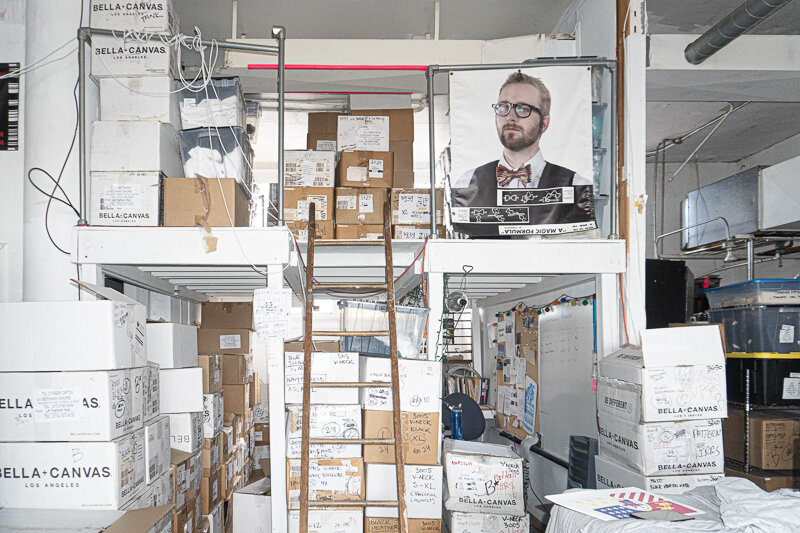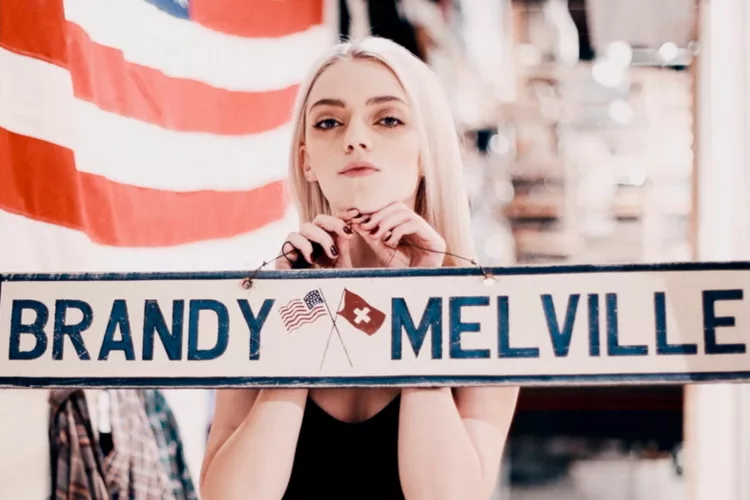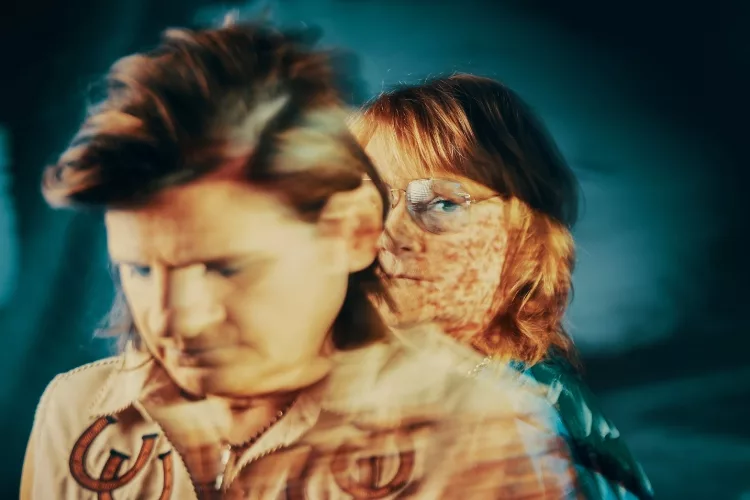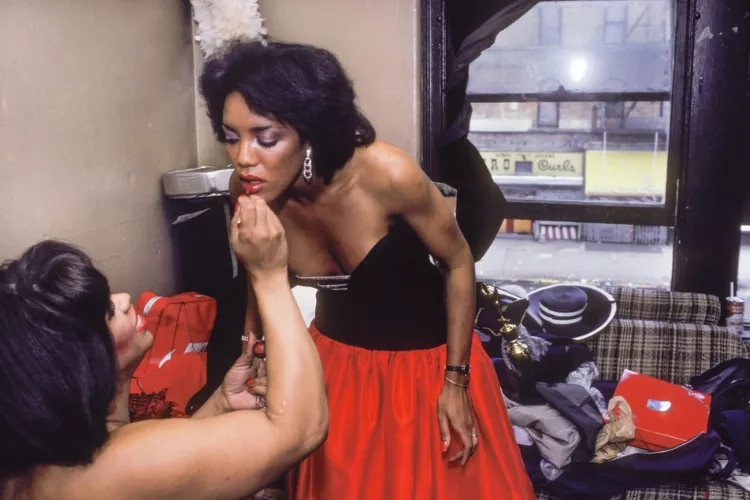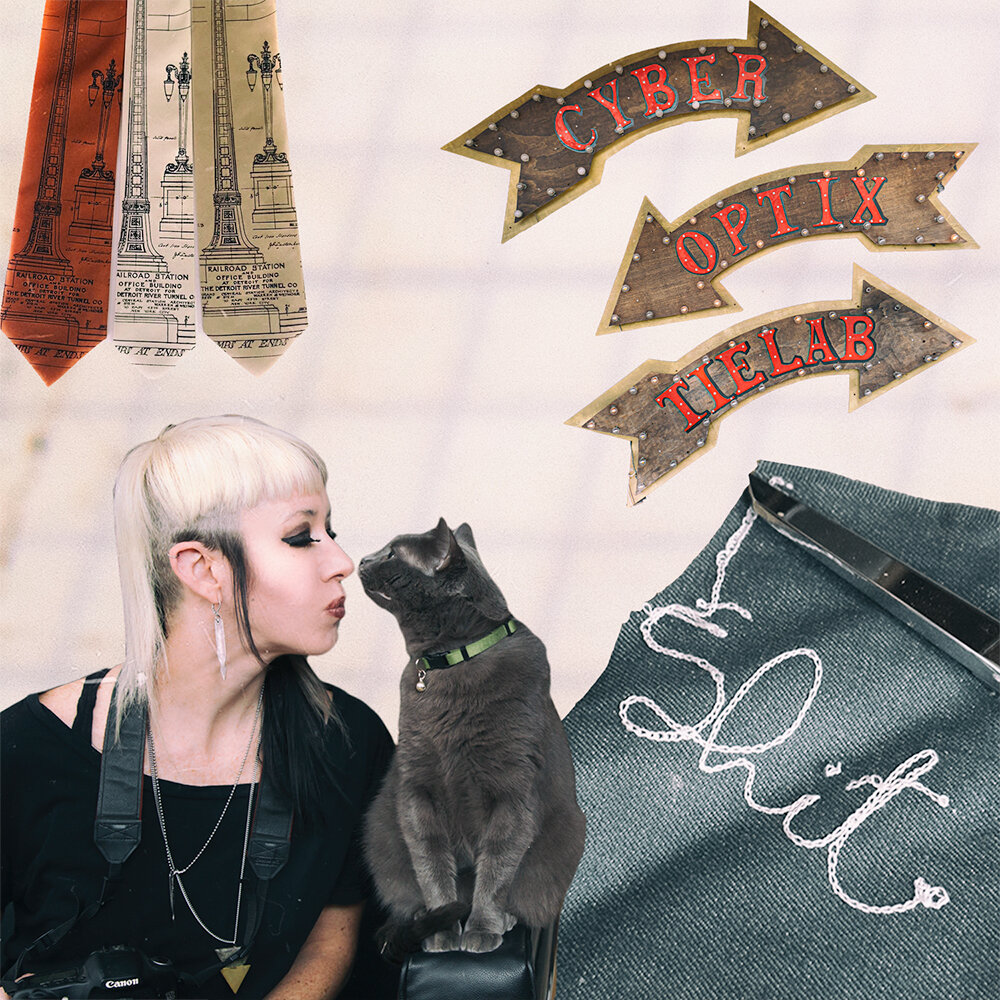
Home of the original “Ties That Don’t Suck, since 2006″, located behind the world reknown Detroit Farmers’ Market, Cyberoptix started as a one woman production silk screening on ties enterprise that has evolved into a Detroit institution. We sat down to find out, from owner and creative director, Bethany Shorb, how a sly punk idea played itself into an international juggernaut on the handmade tie, scarf and tee industry while maintaining its bespoke, expressive elegance.
How did Cyberoptix get started?
Founded in 2006, Cyberoptix is celebrating its 13th year in the heart of Downtown Detroit, along with a 3-year-old bratty techno-obsessed sister shop, the adjacent bricks-and-mortar retail storefront, Well Done Goods. As for the ties, I made a few as a gift, put some photos on the internet back before everyone was on the internet, and it was still a weird and cool nerdy space dominated by independent crafty blogs and not billionaires — I made more and more ties until I had to quit all my day jobs to keep up with demand.
For the first decade, Cyberoptix hand-printed almost exclusively neckties, bow ties and scarves. While wildly successful online, in 2016 a ground-floor storefront became available right downstairs from our workshop, and I realized a product line of exclusively offbeat ties and scarves might not be a sustainable model for a stand-alone bricks-and-mortar shop. Exponentially expanding the product line under the new Well Done Goods umbrella, WDG now makes in-house, just about any item you can put printing ink on. I’m really stubborn and I swore I’d never print t-shirts and hoodies because that’s what everyone else does, yet here we are. After printing nothing but ties for 10 years, having a different shaped object to print on was really refreshing. And we realized a lot more people like t-shirts than ties. Who knew?
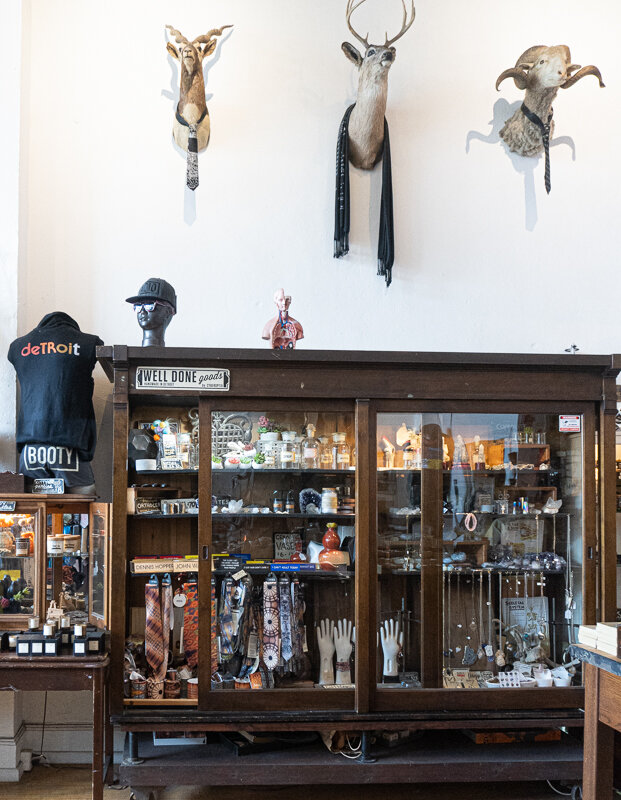
CYB/WDG now employs twenty assisting in the production of screen printed and dye-sublimated work, fulfilling orders, and staffing the retail store on Gratiot Avenue. We also travel to select satellite pop-up boutiques in Detroit and festivals regionally. In addition to a strong internet retail presence, Cyberoptix and Well Done Goods accessories have been represented by more than 450 boutiques and museum stores in over a dozen countries and have shipped to clients on all seven continents, including Antarctica.
Antarctica? That’s crazy! As a sort of artist turned entrepreneur what are some of the challenges you had growing your business / what did you learn along the way?
I’m a workaholic with no concept of time-management, balance or team management, and I pretty severely damaged some relationships by my excruciatingly long hours and commitment to my companies over human relationships. I’d probably advise doing less of that.
How do you define success?
Being able to be fully present in your making-mindset and not worrying about how you’re going to pay your staff, or keep the lights on.
How do you come up with your designs?
Stuff just comes to me, usually at the exact opposite time of when I need to be thinking about new designs – like when I’m in the throes of production work or a deadline and need to focus on that instead of buzzing around like a gnat on something new. Production work is an active meditation that way, and the ideas flow easily, it just takes a lot of discipline not to be scattered about on the seduction of the new new new thing and finish the task at hand.
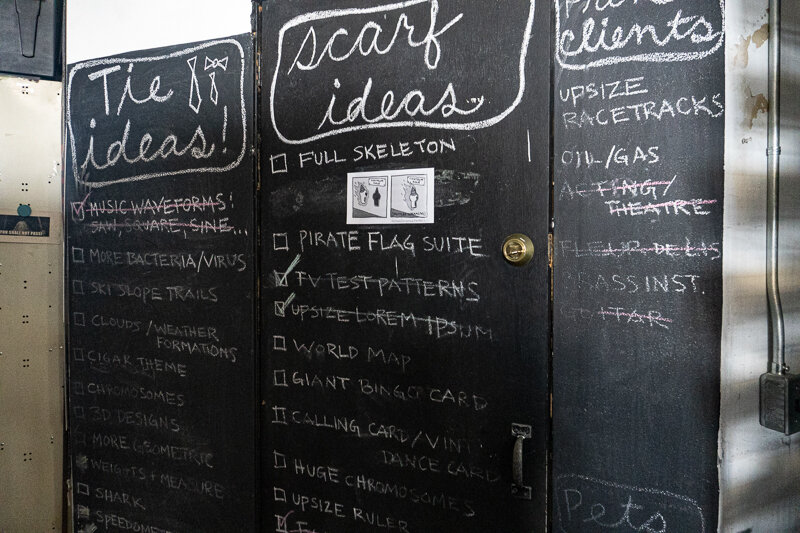
I work with lots of puns and sarcasm, geek, and enthusiast themes and local politics and parodies – and some toilet humor. I try to keep a paper notebook (ok, lies, it’s usually notes on my phone) next to my pillow so I can jot down ideas that are keeping my up when I’m trying to drift off to sleep. If I get them out of my head onto a list, it’s much easier to actually sleep, I’m really bad at sleeping. (Sometimes it backfires and I get up and make stuff instead.) Then I revisit those ideas the next day or even weeks later – some are great, most are crap that seemed brilliant at 4am. I have a running list of hundreds and hundreds of designs still not yet done that got through the “not-crap” filter. Often of a client will request something on that list as a custom job, so I just push that one to the front of the queue and save them the custom fee and waiting time. Recently someone wanted a custom THC molecule necktie to gift to a researcher in his field, but since that was on the to-do list already, it became a priority as it was paying work. If someone is requesting something, chances are other people want it too. It’s a good starting point to triage ideas like that.
How are you sustainable?
We’re committed to knowing each product in both the neckwear and the streetwear divisions is aligned with the values of responsible and sustainable manufacturing; from production, packaging, to our unique print-to-order system of fulfillment. Unheard of at this scale, both WDG and Cyberoptix are waterbase-only print shops using no harmful solvents. We strive for zero waste and donate all our slight misprints and overruns to charitable organizations such as Dress for Success who helps outfit those who have just exited the prison industrial system, and are assembling a professional wardrobe for interviewing for employment.
We answer questions frequently about our line of manhole printed shirts and hoodies, and how that must somehow be harmful. We abide by strict “leave no trace” principles. We only use the same, non-toxic, waterbase printing ink (not what is typically used in the printing industry, especially for garment production). It easily cleans up with water, and it is not permanent until we take the garments back to the studio and go through a round of rigorous 370 degree heating cycles in commercial heat presses to merge the ink with the fabric. It requires a lot more work to do it in the non-harmful manner, but we would not do it any other way. We have the MSDS on all our printing inks and even soaps we use in studio. The ink we use to print the line of manhole shirts and fleece is even safe to eat, however I wouldn’t really recommend it, as it isn’t very tasty and the burger spot next door has far better options, but…hey, you can!
When we post videos of our outdoor printing process, we instruct others that if you decide to try some of these prints on your own, to only use waterbase printing ink and be sure to check the MSDS to know what you’re really working with. Also sure to carry about 5 gallons of water with you, and a strong scrub brush and some absorbent old bath towels to clean up the manhole cover itself and your surrounding area so it is better than you found it. Make sure to pack out any painty masking tape, clothespins, or paper towels used in the printing process.

How are you ethical?
One of the most important parts in our manufacturing process to vet our suppliers to make sure they align with our values, even down to what one would think is the most banal component – shipping supplies. Our divorce-day from the behemoth that is Uline was monumental to our ethics and sustainability – we refuse to support conservative, racist, classist and homophobic companies; and they have come right out as such from open letters from their company founder. If you warehouse or ship anything, I urge you to consider your local mom and pop shipping supply house instead of the very cheap and convenient Uline warehouse. While we had to compromise somewhat on price and immediacy in some instances, it was worth being able to sleep at night.
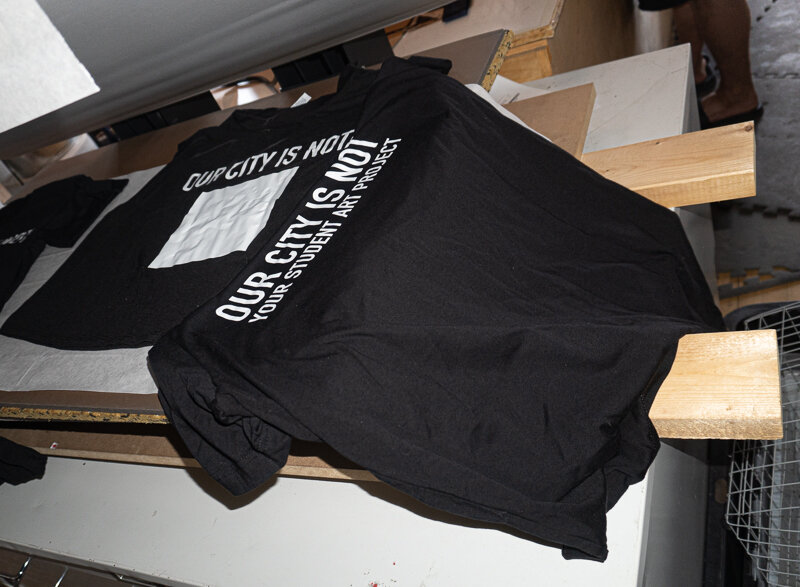
How has Detroit changed since you began?
Mom always said if you don’t have anything nice to say…
Do you think there’s a greater interest/awareness of sustainability?
I think there is some, however more education to the general consumer is needed; I see a lot of preaching tot he choir and it is still far too much of a niche market. The vast majority of people shopping in stores and online truly have no concept of the cost of garment production, and don’t realize that the Walmarts of the world are supporting nothing more than slave wages and environmental catastrophe – but since so few people see the direct impact on US soil, it is out of sight/out of mind.
Can you talk about your partnership with Grow Detroit’s Young Talent?
We’re assisting young people in the city gain a quality work experience for the summer, inspiring their own entrepreneurship skills, so that they can hopefully translate what they’ve learned and eventually create jobs for others in the future. As budgets for art education diminish, we want to demonstrate to young adults that there are still many possibilities for fruitful careers in the arts.
What is exciting you right now? (in your business or just in general)
This year I’ve expanded and set up a mini studio in DTLA. There are so many manufacturing and materials resources there, it is overwhelming in a good way. I’ve back-burnered an art jewelry line for far too long; I’ve been antsy to get back to some more slow, thoughtful art-making instead of so much rote production work. I’ve been working with a lot of raw stones, and will be combining them with 3d printed parts, laser cut aluminum and copper electroforming and plating.
